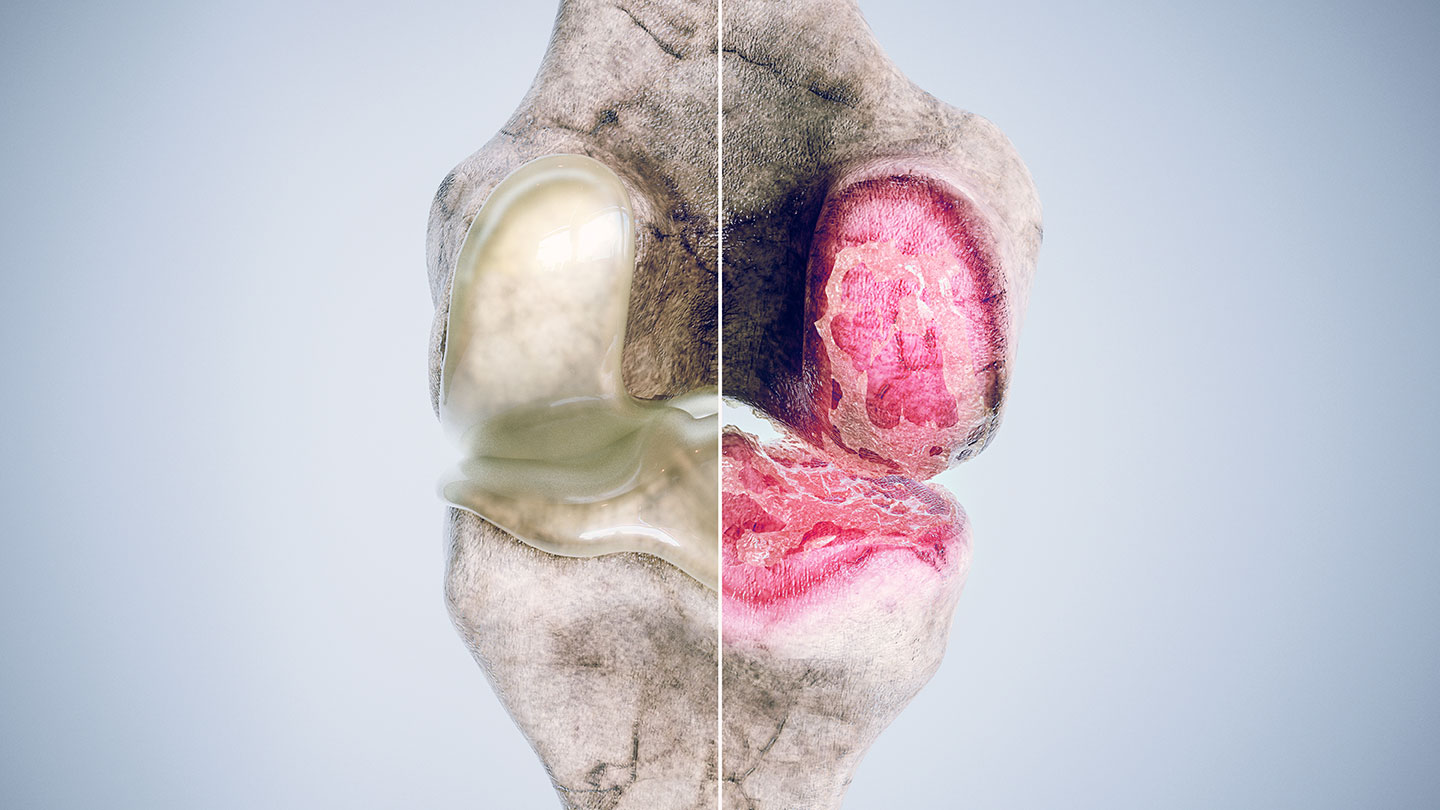What Is Osteoarthritis?
Osteoarthritis is a degenerative joint disease and is the most common form of arthritis. With osteoarthritis, the protective cartilage within a joint stiffens and loses its elasticity, making it more prone to damage. Cartilage within the joint breaks down over time, causing swelling, stiffness, pain, and in some cases reduced function. In addition to the loss of cartilage, osteoarthritis can negatively affect the entire joint. Along with an inflammation of the joint lining, this condition can cause deterioration of the connective tissues that secure the joint and attach muscle to the bone. In some cases, changes in the physical composition of the bones around the affected joints may take place.
Osteoarthritis can occur in nearly any joint in the body, but it is most common in joints that are heavily used or are near the location of a previous injury. This disorder is most prevalent in hip, spine, and knee joints.
What Are Common Osteoarthritis Symptoms?
Since osteoarthritis is a degenerative condition, symptoms tend to show up gradually and worsen over time. It should be noted that osteoarthritis can affect people differently and can range from having no impact on regular activities to causing intense pain and disability. For many, symptoms may appear and disappear in episodes. Common symptoms may include:
- Joint aching and soreness, typically after extended activity
- Limited range of movement
- Pain brought on by overuse or extended periods of inactivity
- Stiffness after rest periods or first thing in the morning
- Audible clicking sounds when a joint bends
- Bony enlargements on the finger joints
- Joint swelling
- Tender and warm joints
What Forms of Osteoarthritis Are Most Common?
Osteoarthritis most-frequently affects the primary weight-bearing joints such as the knee, hip, and spine.
Knee osteoarthritis is the most common form of the condition, which is understandable given its frequent use and impact. Women over the age of 40 are the most-affected demographic of knee osteoarthritis. Knee pain related to this condition is usually linked to activity, walking, and going up and down stairs, and can be heightened if you are carrying excess weight. Aside from pain, knee osteoarthritis can present itself as a grating or scraping feeling within the joint during movements.
Hip osteoarthritis is the second-most common. This condition typically arises around the age of 60, with a higher likelihood of it occurring in those who are overweight, work in hard labor, or have a family history of hip conditions. Pain from hip osteoarthritis generally is present in the groin or buttocks, and can irradiate down to the knee.
Although both hip and knee osteoarthritis are relatively common, pain generated from both can be reduced with a proper treatment of rest, physical therapy, and a well-informed exercise program.

Factors Contributing to Osteoarthritis?
While there is not a defined group that generally suffers from osteoarthritis, there are a variety of factors at play that can increase the likelihood of developing the disorder. These factors include:
- Age and gender: Since this is a normal part of the aging process, as we get older our chance for developing arthritis increases. Women are more likely to develop osteoarthritis, especially for those older than 50.
- Genetics: If others in your family have had osteoarthritis then you are more likely to develop it yourself. One can inherit a defect in the genes responsible for making cartilage, which can lead to faster deterioration of joints. Additionally, those who were born with joint abnormalities are more prone to developing osteoarthritis.
- Obesity: When extra weight is present on your body’s frame, more stress will be put on your weight-bearing joints such as the hips and knees. This can contribute to the deterioration of your joints, and increase the likelihood of developing osteoarthritis. Those who are able to lose excess weight will have a better chance of preventing osteoarthritis or minimizing its impact and rate of progression if the condition is already present.
- Joint overuse and injuries: Overuse and repetitive stress on a joint (consider a dedicated distance-runner, for example) can cause damage and increase the risk of osteoarthritis. Significant injuries such as broken bones that are near or on joints can also contribute to the development of osteoarthritis.
- Race: According to the Centers for Disease Control and Prevention, some Asian populations may have a lower risk for osteoarthritis.
- Weak muscles: If there is not enough muscle support for your joints, it is possible for them to get out of the right position and increase the likelihood of osteoarthritis over time.
Is Physical Therapy for Osteoarthritis Helpful?
For some, osteoarthritis can create enough discomfort that it limits you from the things that you love doing most. This causes many to assume that exercise is no longer an option for them and that they have to sacrifice certain activities they love - but this just is not the case. By combatting symptoms through physical therapy and intentional movements you can return to a form of health that you might have thought was long gone.
At Keystone Therapy, we recommend that our patients continue to perform activities that they enjoy in a pain-free range. Continual pain-free movement helps give nutrition to the joint and can reduce pain and improve range of motion. Our physical therapists are trained to perform an evaluation to see how you can return to activities you love through modifications or a warm-up that greatly improves performance and reduces pain.
When you undergo a physical therapy treatment with us, we can also provide a plan of movements and exercises that can help you preserve and improve your range of motion and build strength in the muscles associated with osteoarthritis joints. After receiving this professional instruction you will know when to do various exercises, for how long, and when to rest in a way that optimizes your health. Our physical therapy provides a roadmap to feeling better and maintaining the ability to do the things you love without the obstacle of pain. We can also provide recommendations for using rest and thermal therapy (heating pads, ice packs, etc.) to ensure that your body and joints are being cared for appropriately.
The Best Exercises for Osteoarthritis
We consider regular, daily exercises that are tailored to your unique situation and directed by a physical therapist to be a key component of managing osteoarthritis. Exercise actually increases the lubrication of the cartilage in the joint, which can have a dramatic effect on your levels of joint pain. Surprisingly, one can develop even stiffer joints and worse symptoms if they do not exercise. Exercise also can lead to better overall health and potentially weight loss which will decrease the amount of pressure on your joints and help reduce pain in cases of osteoarthritis in weight-bearing joints. Still, we must be mindful of how we exercise because overexertion can exacerbate your osteoarthritis.
Your exercise program should be crafted by a knowledgeable physical therapist. While each person is different, the best physical therapy exercises for osteoarthritis are generally those that are low-impact and not stressful on your joints. This is especially important if you have knee osteoarthritis or are affected in another weight-bearing area. There are three key areas of exercise that are particularly helpful for people with osteoarthritis:
- Aerobic exercise: Consider briskly walking, swimming, water exercises, dancing, some aerobics, or using a low-impact exercise machine such as an elliptical trainer or a stationary bike. It is likely that a physical therapist will prescribe these types of exercises that take much less of a toll on your body’s joints. The important thing is to get moving and get your heart rate up. For most who are trying to manage their osteoarthritis through exercise, a good goal to shoot for is 30 minutes a day, five times a week. Resting in between workouts and on off-days will also help you stay fresh and consistent over time.
- Resistance training: Your physical therapist should provide you with resistance training options that strengthen the muscles around the joints that are causing you pain. This could come in the form of light-dumbbell or machine-weight exercises, or resistance bands that use your bodyweight and gravity to help build strength even if you do not have access to a gym. If possible, resistance training should happen two to three days a week for best results. If you are lifting weights, ease into the process and start with low weights initially. These exercises should help alleviate pain, so if your joint areas are hurting more the day following your resistance training it is likely that you have pushed yourself too much.
- Range of motion exercises: While physical therapy will provide you with specific movements that target range of motion around osteoarthritis-affected joints, you can amplify your results while promoting full-body flexibility by taking part in a yoga or Pilates class. These types of exercises will reduce joint stiffness and promote better health in both the body and mind. Pilates should promote better circulation, improved posture, and lengthened and strengthened muscles which should all help to improve osteoarthritis symptoms. Yoga should help with flexibility and reduce stress, and we recommend starting with a beginners-level class and taking things slow if you are new to this exercise.
Conclusion
Osteoarthritis is a highly common condition that occurs naturally as we age and affects over 32.5 million adults in the United States alone. While in severe cases it can be debilitating at times, with the proper physical therapy and exercise we can predictably reduce pain and improve range of motion in affected joints. It is important that you work directly with a physical therapist who understands this condition and can recommend specific treatment options to improve your health and quality of life. Therapy and exercise under the guidance of an effective physical therapist can equip you with the knowledge needed to continue managing your osteoarthritis symptoms at home.
If you or someone you love is experiencing osteoarthritis symptoms, Keystone Therapy is here to help you find ways to manage the condition, improve your overall health, and get back to doing the things you love. Please contact us to get started.

